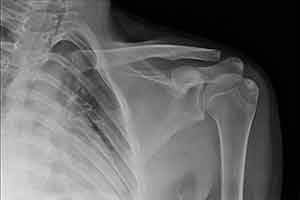Study Compares Outcomes for Surgical vs Non-Surgical Treatment of Broken Shoulder
 Among patients with a displaced proximal humeral fracture, there was no significant difference between surgical treatment and nonsurgical treatment in patient-reported outcomes over two years following the fracture, results that do not support the trend of increased surgery for patients with this type of fracture, according to a study in the JAMA.
Among patients with a displaced proximal humeral fracture, there was no significant difference between surgical treatment and nonsurgical treatment in patient-reported outcomes over two years following the fracture, results that do not support the trend of increased surgery for patients with this type of fracture, according to a study in the JAMA.
Proximal humeral fractures account for 5 percent to 6 percent of all adult fractures; an estimated 706,000 occurred worldwide in 2000. The majority occur in people older than 65 years, and the age-specific incidence of these fractures is increasing. Approximately half of these fractures are displaced, the majority of which involve the surgical neck (located on the upper portion of the humerus).
Surgical treatment is being increasingly used, contributing to increased treatment costs for upper limb fractures. A review of results from randomized clinical trials found insufficient evidence to conclude whether surgical intervention produces consistently better outcomes than nonsurgical treatment, according to background information in the article.
Amar Rangan, F.R.C.S. (Tr. & Orth.), of James Cook University Hospital, Middlesbrough, England, and colleagues randomly assigned 250 patients (average age, 66 years) who sustained a displaced fracture of the proximal humerus involving the surgical neck to surgical treatment (fracture fixation or humeral head replacement) or nonsurgical treatment (sling immobilization). Standardized outpatient and community-based rehabilitation was provided to both groups. Patients were followed up for 2 years and 215 had complete follow-up data. The data for 231 patients (114 in surgical group and 117 in nonsurgical group) were included in the primary analysis.
The researchers found that there were no statistically or clinically significant differences between surgical and non-surgical treatment either overall or at individual time points (at 6, 12, and 24 months) for the Oxford Shoulder Score (OSS), a shoulder-specific outcome measure that provides a total score based on the patient’s subjective assessment of pain and function. In addition, there were no clinically or significant differences on measures of health-related quality of life, complications related to surgery or shoulder fracture, complications requiring secondary surgery or treatment, and death.
Ten medical complications (2 cardiovascular events, 2 respiratory events, 2 gastrointestinal events, and 4 others) occurred in the surgical group during the postoperative hospital stay.
“These results do not support the trend of increased surgery for patients with displaced fractures of the proximal humerus,” the authors conclude.
Source Newsroom: JAMA – Journal of the American Medical Association
Citations
JAMA

